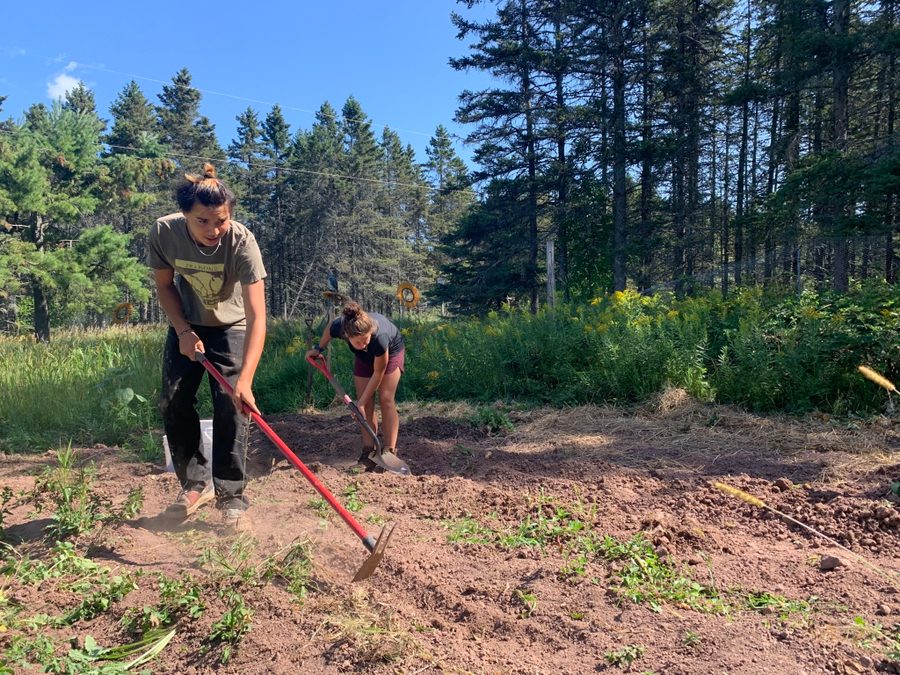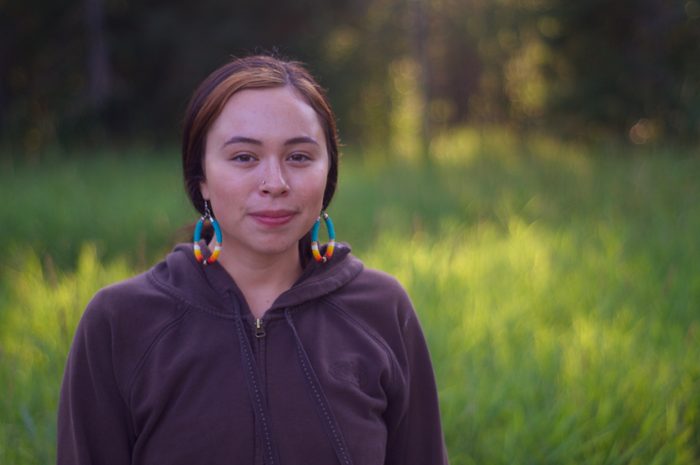Growing food sovereignty on the shores of Lake Superior
On a small Wisconsin island, members of the Bad River Band of Lake Superior Chippewa and volunteers provide fresh food and restore ancestral connection through gardening.
Kip Dooley

On Madeline Island, an ancestral homeland of the Anishinaabe people, fresh food is surprisingly scarce. This island on Lake Superior is home to an affluent vacation community and almost 300 year-round residents. Before Big Agriculture took over, dairy farms once dotted the south shore of Lake Superior, and before that abundant game and foraging. Though lake fish and berries still abound, it’s far easier to find pizza and french fries in the town center of La Pointe than fresh cheese or wild rice. At the island’s lone year-round grocery store, a plastic-wrapped tray of six miniature cucumbers sells for $6.50.
But at the Madeline Island Community Garden, new possibilities are taking root. On a late July evening, I join a dozen or so garden members – both “summer people” like myself and year-round residents who volunteer work hours in exchange for fresh produce – to learn about the theory and practice of food sovereignty from Joy Schelble, food educator.
After parking my bike by an aluminum camper-turned-chicken coop, I meet Ginge Anderson, a garden member and summer cabin-owner from Deephaven, Minn. She leads me through rows of beans and broccoli. “There’s a beauty,” she says, crouching to brush dirt from a head of cauliflower. “I’m so glad we had that rain.” It’s been a dry summer, delaying the Island’s already-short growing season. By early August, corn and tomatoes were just starting to appear.
We meander into a clearing between the toolshed and the duck pond, where Schelble is handing out stems of a delicate plant with sawtooth leaves that shade purple at the center. She encourages us to go ahead and taste it. Lamb’s quarters, which most people assume is just a weed, is packed with vitamins and minerals. Plus, it stains your hands magenta, which delights the kids she works with.
Schelble works with the Bad River Band of Lake Superior Chippewa, as a non-native Federally Recognized Tribal Extension Program Educator. Like other Anishinaabeg, Bad River band members were forced to leave Madeline Island in the years following the 1854 Treaty of LaPointe for reservation lands away from their traditional hunting grounds, often in places isolated from good food, housing and employment. In 2017, the Bad River tribe regained control of the Amnicon Bay shoreline on the Island’s north end. There, and around the Island, Indigenous people are through community events, traditional ceremonies, and educational trips for youth restoring their ancestral connection to Mooniingwanekaaning-minis (“The place of the golden-breasted flicker bird”).
As she settles into the grass to begin her talk, Schelble introduces Madelyn Wiggins, a college student and Bad River tribal member. Wiggins met Schelble at the Bad River Gitiganing Community Garden when she was 10, and is now an intern working with the youth. “Plants hold so much power, but their medicinal properties get lost in our pharmaceutical environment,” she says. Systemic poverty and the intergenerational traumas of colonization make auto-immune disorders common in the Bad River community. Along with her friends, Wiggins makes healing teas for community elders using herbs like chamomile, lemon balm and stevia. “We call it ‘Blissful Time Tea.’”

Loretta Livingston, Director of Bad River Food Sovereignty, tells me later, “We can relearn how to use the environment, plants and traditional medicines to survive as our people before us did,”
In addition to distributing free and low-cost produce through Bad River’s HeadStart and farmer’s markets, Loretta runs a Dine & Learn program, bringing in local experts who share with the community traditional Anishinaabe skills that have largely fallen out of practice due to colonial policies that disrupted knowledge transmission and connections to land. One class taught a variety of ways to use bear fat, including medicinal salves; another, weaving baskets from birch bark and black ash. “Anytime of the year, there’s something you can harvest, you can do, that will help you survive and fend for yourself and provide for your family,” says Livingston.
Schelble works with Livingston’s program and tribal youth through the University of Wisconsin Extension, and says that as a non-native educator, connecting with kids has been key to developing trusting relationships with elders and parents.
Recalling her early days as a food stamp educator, Schelble says, “You have your display, you have your pamphlets, and then you ‘should’ all over people: ‘you should eat your spinach,’ ‘you should do this,’ ‘you should do that’. ” When she arrived at Bad River Reservation nearly 20 years ago, parents and elders told her, “Don’t do the pamphlet thing. We want you to do things that get our kids in their bodies, that get them moving.”
Schelble worked with community leaders Luis Salas, Becky Lemieux and Danny Powless, Sr. to expand existing community gardens, and tapped the expertise of non-native organic farmers through UW-Extension. “I had an opportunity to really present myself as a neighbor, a friend and a helper,” she says as she lays out laminated photos of Bad River band kids grinding corn, hiking in the woods and playing baaga’adowewin (lacrosse).
Food sovereignty, a term originated by the global peasant movement La Via Campesina, is the right of peoples to grow, access and eat healthy foods that reflect their culture and are good for the land. It pushes against the dominant paradigm of food security, which often prioritizes market-based solutions that keep communities dependent on cheap food, instead of restoring traditional foodways disrupted by settler colonialism.
“A lot of what we call ‘innovative’ in agriculture,” like rotational cropping, companion planting, and biodynamics, “is really just old, indigenous ways,” says Schelble.
This was one of many realizations – some more painful than others – that she describes from nearly 20 years of working as a non-native person in Indian country. Among the toughest was how many 4-H programs exclude native youth.
“When you look at something you’ve been proud of your whole life and you see it in a different way, there’s grief and pain. You have to go there.” But, Schelble says, “don’t do it on a public Zoom call, or in front of indigenous people…do that grieving alone or with people that love you. Then, we have work to do.”
Madeline Gould, another island farmer, says she’s learned a lot from Marty Curry, an Anishinaabe grower of the Saginaw Chippewa Indian Tribe, whose farm is down the road from the community garden. “It’s best to learn from nature, and mimic how nature operates. That’s how plants like to live, and you get the best results from that.”
Food sovereignty is not just about growing commodities, says Janet Moore, the Madeline Island Community Garden manager. The garden’s efforts are also to “produce food that ends up as part of a feast, or really beautiful hospitality cooking here on the farm where people can enjoy the land together.”
Curry’s farm, which partners with the community garden to grow produce for a food shelf at the Island church, provides a similar space for native youth groups, elders, activists and politicians to reconnect with Mooniingwanekaaning-minis. “It’s important that we stay connected with where we started in this area as Ojibwe people,” says Livingston. “It’s part of people being connected to the land, to medicines, to the animals, all our spiritual beliefs.”
I meet Chetan Goodshield at Curry’s farm later in the week, a 15-year-old whose Anishinaabe ancestors fled this region to escape the terror of Indian boarding schools. Farming and enjoying potlucks at Curry’s farm inspires him to get friends back home in Tucson, Ariz. into growing their own food. “It’s not just all hard labor, it’s more than that, it’s deeper than that. Caring for a plant so later it cares for you, you get what you give. It’s about connections.”
At the community garden, Moore says membership jumped during the first year of Covid-19. About 65 people now have a harvest share or garden plot on an island with a year-round population of almost 300. “We’ve got droughts, wildfires, we saw with the pandemic what it’s like to have supply chains collapse,” she says.
Despite the challenges posed by Covid-19, Madelyn Wiggins says she sees momentum in the Bad River community, too. “More people are getting interested in growing food, enjoying food, having fun cooking with family.” Wiggins is also thinking of majoring in Agriculture and Natural Resource Management at Lac Courte Oreilles Ojibwe College in Hayward, Wis.. Growing and cooking your own food in your community “is good for gut health, for mental health, for preventing addiction,” she says. “It’s all connected.”




